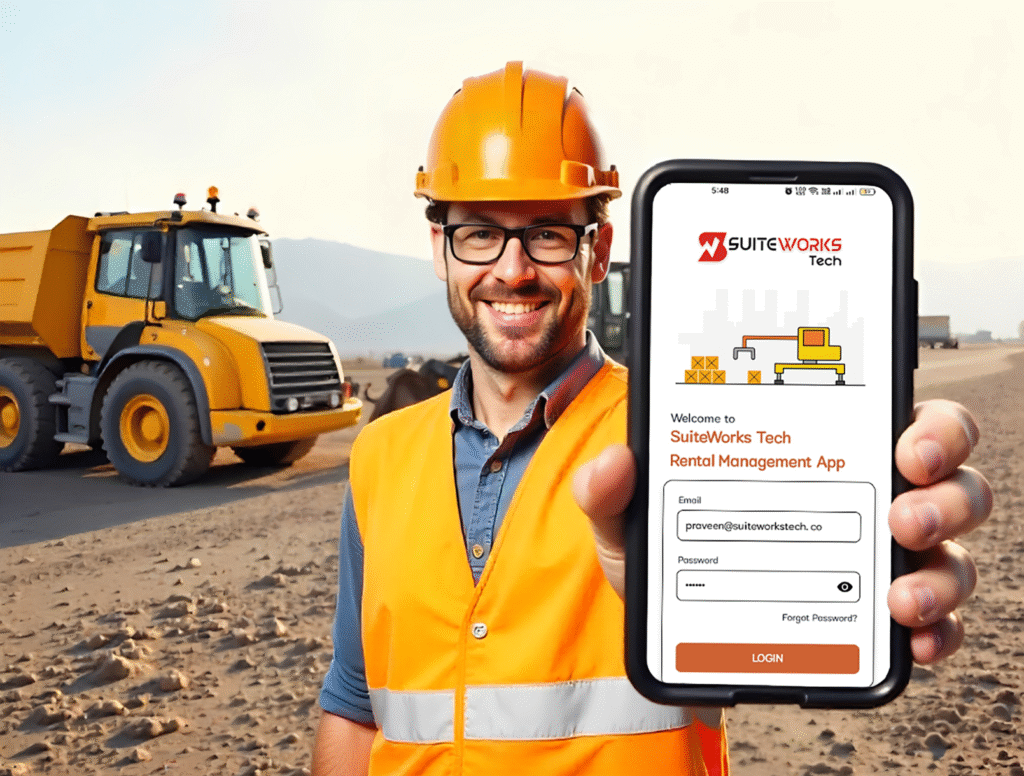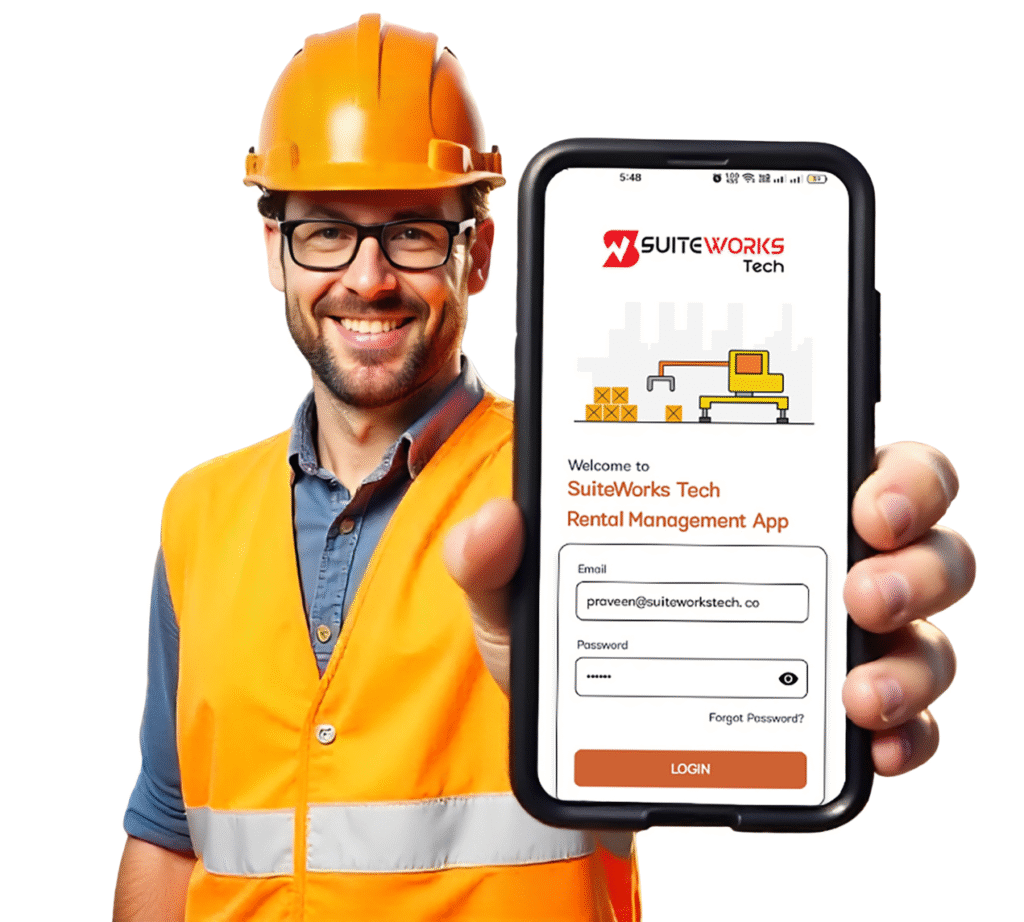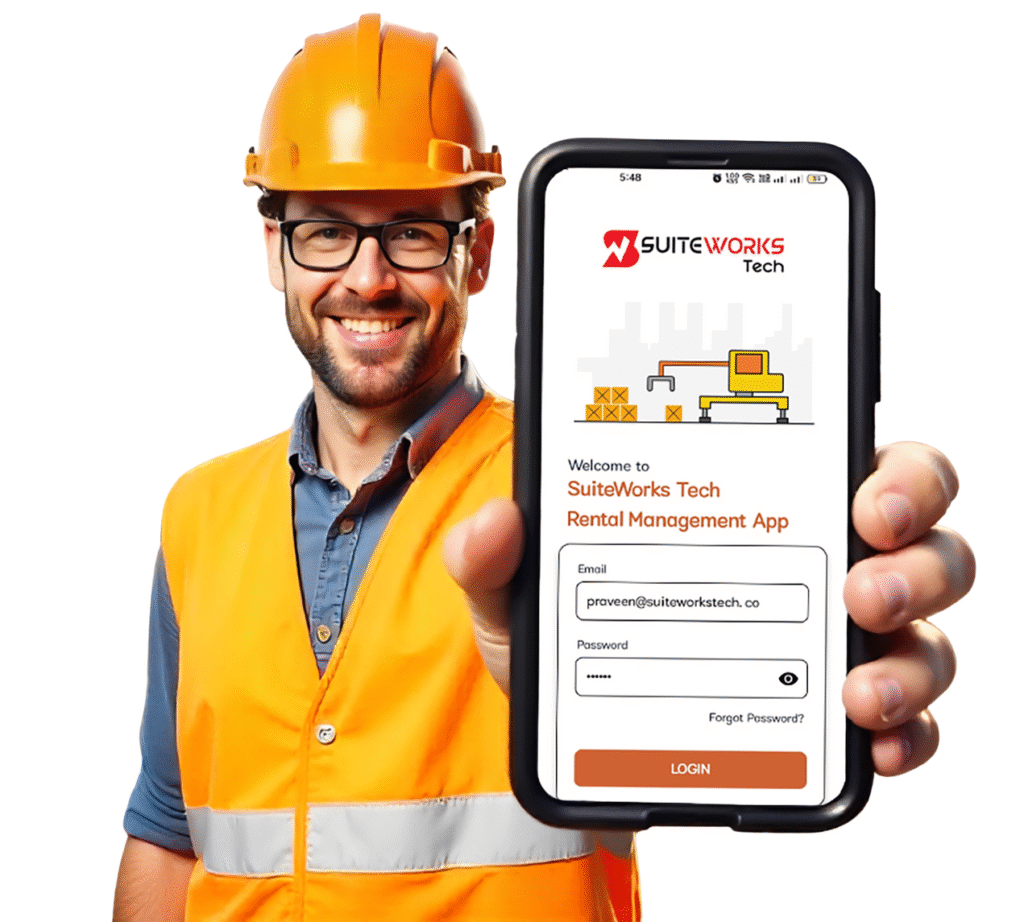Fleet & Vehicle Rentals Made Easy with NetSuite Rental Management

Fleet & Vehicle Rentals Made Easy with NetSuite Rental Management By Manasa, Sr. NetSuite Solution Architect at SuiteWorks TechAugust 30, 2025 Running a fleet or vehicle rental business is not just about handing over keys—it’s about managing contracts, ensuring timely billing, keeping vehicles road-ready, and delivering a seamless customer experience. With multiple bookings, varied rental durations, maintenance schedules, and pro-rata billing, businesses often find themselves struggling with fragmented systems and manual processes. That’s where NetSuite Rental Management is changing the game. Designed as a native SuiteApp, it brings together contracts, billing, shipments, returns, and maintenance under one unified system. For fleet and vehicle rental providers, this means fewer errors, faster processes, and more satisfied customers. At SuiteWorks Tech, a trusted NetSuite Solution Provider, we’ve built a robust NetSuite Rental Management Software that helps businesses take control of their rental operations with precision and flexibility. Why Fleet and Vehicle Rentals Are Complex Managing fleet rentals isn’t as simple as filling out a contract. Every vehicle has its own lifecycle, maintenance needs, and utilization rates. The challenges usually include: 🔹Multiple rental durations (hourly, daily, weekly, monthly) 🔹Pro-rata billing for mid-cycle starts and ends 🔹Real-time vehicle availability across locations 🔹Maintenance scheduling to avoid unexpected breakdowns 🔹Quality checks and returns for every handover 🔹Subcontracting vehicles when in-house availability runs out When handled manually, these complexities often lead to errors in invoicing, double-bookings, or underutilization of assets—directly affecting customer trust and profitability. Fleet Rentals Made Seamless with NetSuite Rental Management Digital Rental Contract Management Fleet providers can capture every detail of vehicle rental contracts—pricing, frequency, duration, and terms—digitally within NetSuite Rental Management. This ensures nothing is lost and every contract is traceable. Automated Billing and Pro-Rata Calculations Whether you rent cars for a week, vans for a month, or trucks by mileage, the system automatically calculates charges and generates invoices on time. Pro-rata billing ensures fair charges for mid-period rentals. Shipment, Returns, and Quality Checks From assigning vehicles for pickup to receiving them back with condition checks, the process is streamlined. Built-in workflows ensure customers get road-ready vehicles and returns are handled without delays. Maintenance and Usage Tracking Fleet managers can automate service schedules based on mileage or usage hours. Logs can be recorded directly via the mobile app, reducing downtime and extending vehicle life. Real-Time Availability and Scheduling Avoid overbooking by checking which vehicles are available now or reserved for future dates. The rental calendar shows both rentals and maintenance schedules for better planning. Subcontract PO Creation When all vehicles are booked, the system can create subcontract purchase orders with preferred vendors, ensuring customer demand is always met. A Fleet Rental Story Powered by NetSuite Rental Management Imagine a regional vehicle rental business managing hundreds of cars, vans, and trucks. 🔹Before: Bookings were managed in spreadsheets. Customers were often told a vehicle was available—only to be disappointed. Billing was late, and maintenance was reactive. 🔹After: With NetSuite Rental Management, contracts are recorded digitally, invoices are auto-generated—even for short-term rentals—and the fleet availability calendar shows which vehicles are ready at any moment. Preventive maintenance jobs are scheduled automatically, reducing unexpected downtime. The result? A reliable rental experience, improved fleet utilization, and better customer loyalty. Key Benefits for Fleet & Vehicle Rental Businesses 🔹Efficiency Gains: Automate contracts, billing, and scheduling. 🔹Increased Utilization: Keep vehicles circulating with real-time availability checks. 🔹Improved Cash Flow: Accurate, on-time invoicing improves revenue predictability. 🔹Prolonged Asset Life: Maintenance scheduling ensures vehicles remain in peak condition. 🔹Superior Customer Experience: Reliable vehicles and accurate billing build trust. For businesses where every rental impacts profitability, these benefits make NetSuite Rental Management a strategic advantage. NetSuite Rental Management Mobile App Field operators and managers often need tools on the go. With the NetSuite Rental Management Mobile App, they can: 🔹Log mileage and usage hours on-site 🔹Generate estimates and rental orders in the field 🔹Approve or review operator logs instantly And since every update syncs directly with NetSuite, businesses always work with accurate, real-time data. Industry-Specific Flexibility in Fleet Rentals Not every fleet rental business is the same. Some focus on passenger cars, others on commercial trucks, vans, or specialized vehicles. SuiteWorks Tech’s NetSuite Rental Management adapts to these needs with configurable workflows that support: 🔹Short-term rentals for individuals or events 🔹Long-term leases for corporate fleets 🔹Subcontracted vehicles when demand exceeds supply 🔹Mixed business models of rental and sales With native integration into NetSuite’s Fixed Asset Management, businesses also gain financial visibility into depreciation, asset value, and reporting—all in one place. Driving Fleet Rentals Forward with NetSuite Rental Management For fleet and vehicle rental businesses, efficiency and reliability are the keys to staying competitive. With NetSuite Rental Management, companies gain control of their rental lifecycle—from contracts and billing to maintenance and real-time availability. By unifying these workflows under a single platform, fleet providers can reduce manual overhead, improve fleet utilization, and ensure vehicles are always customer-ready. And with SuiteWorks Tech as a trusted NetSuite Solution Provider, businesses can leverage a rental solution that scales with their needs, industry, and future growth. Book a Free Consultation with Our NetSuite Experts Our NetSuite Solutions Written By Manasa Manasa is a Senior NetSuite Solution Architect at SuiteWorks Tech, with over 10 years of experience designing and implementing NetSuite-based solutions across industries. She has led successful implementations across retail, distribution, manufacturing, and service-based industries. Her expertise spans automation, customization, and AI integration for NetSuite systems. She specializes in creating tailored SuiteApps that streamline operations and increase ROI.
NetSuite Rental Management for Heavy Machinery Manufacturing Businesses

NetSuite Rental Management for Heavy Machinery Manufacturing Businesses By Manasa, Sr. NetSuite Solution Architect at SuiteWorks TechAugust 30, 2025 Heavy machinery manufacturers often face a unique challenge: how to efficiently manage equipment that’s both produced for sale and rented out for short- or long-term projects. From bulldozers and cranes to industrial-grade production machinery, these assets represent a significant investment. The pressure to maximize utilization while ensuring accurate billing, maintenance, and contract management can strain traditional systems. This is where NetSuite Rental Management is redefining operations. By unifying contracts, billing, and equipment tracking within NetSuite, manufacturers gain a single platform to run their rental workflows—making the process more predictable, profitable, and scalable. At SuiteWorks Tech, a trusted NetSuite Solution Provider, we’ve built a NetSuite Rental Management Software designed specifically for businesses like heavy machinery manufacturers who need complete control over rentals while keeping their production side running seamlessly. The Rental Challenge for Heavy Machinery Manufacturers Manufacturing businesses don’t just sell machinery; they also lease or rent equipment to contractors, construction companies, and industrial projects. But managing this dual responsibility presents unique hurdles: 🔹Complex rental contracts with varied durations and terms 🔹Pro-rata billing when rentals don’t follow standard cycles 🔹Tracking real-time availability of machinery across locations 🔹Scheduling preventive maintenance to avoid breakdowns on job sites 🔹Managing returns, quality checks, and replacement requests 🔹Handling subcontracted rentals when equipment is unavailable Without automation, these tasks can easily become overwhelming, leading to billing errors, underutilized assets, and dissatisfied customers. How NetSuite Rental Management Transforms Heavy Machinery Rentals Rental Contracts Simplified With NetSuite Rental Management, every contract—whether for a forklift rented weekly or a crane leased for six months—is captured digitally. Terms like pricing, billing schedules, and duration are automatically enforced. Automated Billing and Pro-Rata Calculations Manufacturers can automate invoicing based on contract frequency, usage hours, or partial rental periods. This ensures accurate and timely cash flow while reducing administrative overhead. Shipment, Returns, and Quality Control Coordinating equipment delivery is simplified with built-in shipment and return tracking. Quality check workflows allow businesses to ensure machines are job-ready and replace faulty assets instantly. Maintenance and Usage Tracking The system auto-generates maintenance job orders based on usage logs or defined thresholds. Operators can log machine hours directly from the mobile app, ensuring accurate maintenance schedules and extending asset life. Real-Time Equipment Availability Manufacturers gain complete visibility into which machines are available now, reserved for future projects, or under service. This prevents double-bookings and maximizes utilization. Subcontracting Made Simple If a manufacturer’s rental fleet is fully booked, NetSuite Rental Management auto-creates subcontract purchase orders with preferred vendors, ensuring customer needs are always met. NetSuite Rental Management for Heavy Machinery: A Story in Action Picture a heavy machinery manufacturer renting excavators to a large construction firm. 🔹Before: Rental contracts were managed on spreadsheets, invoices were delayed, and maintenance was often reactive. When machines broke down mid-project, it caused costly delays. 🔹After: With NetSuite Rental Management, contracts are digitized, invoices are auto-generated—even for mid-cycle rentals—and preventive maintenance jobs are scheduled based on logged hours. Managers have dashboards showing fleet availability, reducing downtime and improving customer satisfaction. The result? A more reliable rental business model and stronger relationships with contractors. Key Benefits for Heavy Machinery Manufacturers 🔹Operational Efficiency: Automate contracts, billing, and logistics to save time. 🔹Maximized Utilization: Keep machines in circulation with real-time availability checks. 🔹Improved Cash Flow: Timely, automated invoicing ensures predictable revenue. 🔹Extended Asset Life: Usage-based maintenance protects investments. 🔹Customer Satisfaction: Accurate billing, on-time deliveries, and reliable equipment build trust. For businesses relying on high-value machinery, these benefits directly translate into profitability and competitive advantage. NetSuite Rental Management Mobile App for Field Teams Heavy machinery often operates in remote job sites. With the NetSuite Rental Management Mobile App, operators and managers can: 🔹Log equipment usage hours on-site 🔹Generate rental orders or estimates from the field 🔹Approve or review operation logs instantly Because every update syncs directly with NetSuite ERP, manufacturers always have accurate, real-time data without requiring extra licenses. Industry-Specific Flexibility The strength of SuiteWorks Tech’s NetSuite Rental Management Software lies in its adaptability. For heavy machinery manufacturing businesses, workflows can be tailored to address: 🔹Short-term rentals for project-based work 🔹Long-term leases with maintenance contracts 🔹Mixed models of rentals and equipment sales 🔹Subcontracted equipment to fill capacity gaps By leveraging NetSuite’s native integration with Fixed Asset Management, manufacturers gain the full picture: from financial reporting to equipment depreciation and lifecycle tracking. Heavy Machinery Manufacturers Moving Forward with NetSuite Rental Management For heavy machinery manufacturers, rental management is no longer just an add-on service—it’s a critical revenue stream. With NetSuite Rental Management, businesses gain control, visibility, and automation that traditional tools can’t provide. By bringing contracts, billing, logistics, and maintenance under one unified system, manufacturers can deliver a smoother rental experience, protect their high-value assets, and strengthen customer relationships. And with SuiteWorks Tech as a trusted NetSuite Solution Provider, manufacturers can confidently adopt a solution designed to scale with their business and industry demands. Book a Free Consultation with Our NetSuite Experts Our NetSuite Solutions Written By Manasa Manasa is a Senior NetSuite Solution Architect at SuiteWorks Tech, with over 10 years of experience designing and implementing NetSuite-based solutions across industries. She has led successful implementations across retail, distribution, manufacturing, and service-based industries. Her expertise spans automation, customization, and AI integration for NetSuite systems. She specializes in creating tailored SuiteApps that streamline operations and increase ROI.
NetSuite Rental Management for Real Estate and Property Leasing

NetSuite Rental Management for Real Estate and Property Leasing By Manasa, Sr. NetSuite Solution Architect at SuiteWorks TechAugust 30, 2025 In the real estate and property leasing world, managing rentals is a delicate balance. Contracts, billing cycles, maintenance, and tenant demands must all align seamlessly. Yet, many property managers still struggle with scattered systems, manual spreadsheets, and delayed invoicing. The result? Missed revenue opportunities and frustrated tenants. This is where NetSuite Rental Management is transforming property leasing. By unifying contracts, billing, and property tracking inside NetSuite, real estate companies gain the control and visibility they’ve long needed. At SuiteWorks Tech, a trusted NetSuite Solution Provider, we’ve seen firsthand how property businesses are reimagining leasing operations with our NetSuite Rental Management Software. Challenges in Real Estate Leasing Operations Leasing property isn’t just about securing tenants—it’s about managing every detail that comes afterward. Without a robust system, companies face: 🔹Manual and error-prone contract tracking 🔹Delayed or inaccurate billing 🔹Lack of real-time availability visibility 🔹Reactive maintenance instead of preventive care 🔹Limited reporting for financial planning These pain points often lead to lost revenue, inefficiencies, and unhappy tenants. Real estate businesses need more than just a property management tool—they need a rental solution built directly within NetSuite. Why NetSuite Rental Management Matters in Real Estate With property portfolios growing in size and complexity, the industry requires a system that automates tasks, reduces manual overhead, and ensures smooth tenant experiences. That’s exactly what the NetSuite Rental Management Software delivers. Core Features for Property Leasing 🔹Rental Contract Management: Every lease agreement—pricing, duration, terms—is captured and traceable. 🔹Automated Billing & Pro-Rata Charges: Invoices are generated accurately for monthly, quarterly, or partial lease periods. 🔹Maintenance Scheduling: Preventive jobs are auto-triggered based on time intervals or usage thresholds. 🔹Real-Time Property Availability: Gain instant insight into which units are leased, available, or under maintenance. 🔹Contract Renewals, Upgrades, and Terminations: Adjust lease terms effortlessly while keeping billing aligned. 🔹Fixed Asset Integration: Connects seamlessly with NetSuite’s Fixed Asset Management for depreciation and financial reporting. With these features, property leasing moves away from reactive management and into proactive, data-driven workflows. NetSuite Rental Management for Real Estate in Action Imagine a property management company overseeing dozens of residential units and commercial spaces. 🔹Before NetSuite Rental Management: Leases were tracked manually, invoices were often delayed, and tenants complained about billing inconsistencies. Maintenance schedules were reactive, leading to costly last-minute repairs. 🔹After NetSuite Rental Management: Lease agreements are digitally captured, invoices are auto-generated with pro-rata billing when needed, and preventive maintenance ensures properties stay in prime condition. Managers get real-time visibility into occupancy rates, while tenants enjoy transparent, consistent billing. The transformation is clear: efficient operations, healthier cash flow, and happier tenants. Benefits for Real Estate and Leasing Companies Companies adopting NetSuite Rental Management are seeing tangible results: 🔹Streamlined Leasing Operations: Automation reduces manual intervention. 🔹Improved Cash Flow: Timely billing keeps revenue predictable. 🔹Reduced Vacancies: Real-time availability ensures faster tenant onboarding. 🔹Asset Longevity: Preventive maintenance extends property and equipment life. 🔹Data-Driven Decisions: Reports and dashboards provide insights into occupancy, revenue, and tenant history. For real estate, these benefits translate into both operational efficiency and higher tenant satisfaction. Mobile Access for Property Managers Real estate managers and field staff often work outside traditional offices. With the NetSuite Rental Management Mobile App, they can: 🔹Review lease contracts on the go 🔹Log property inspections and maintenance requests 🔹Approve tenant entries or operator logs anytime, anywhere Because the app integrates directly with NetSuite, every update syncs instantly, eliminating delays and duplicate entries. Industry Alignment and SuiteWorks Tech Expertise Real estate and property leasing require flexibility—something generic systems can’t provide. With SuiteWorks Tech, companies gain a partner that understands how to align NetSuite’s rental workflows to leasing-specific needs. As a seasoned NetSuite Solution Provider, SuiteWorks Tech helps design solutions that simplify leasing, reduce downtime, and maximize ROI—all while staying seamlessly integrated inside NetSuite. Reimagining Real Estate Leasing with NetSuite Rental Management The future of real estate leasing belongs to businesses that embrace automation and data-driven control. With NetSuite Rental Management, property managers move beyond manual processes into a fully integrated ecosystem where contracts, billing, availability, and maintenance all work together seamlessly. For real estate companies, this isn’t just about efficiency—it’s about delivering a better tenant experience and building sustainable growth. And with SuiteWorks Tech guiding the way, property leasing becomes smarter, faster, and future-ready. Book a Free Consultation with Our NetSuite Experts Our NetSuite Solutions Written By Manasa Manasa is a Senior NetSuite Solution Architect at SuiteWorks Tech, with over 10 years of experience designing and implementing NetSuite-based solutions across industries. She has led successful implementations across retail, distribution, manufacturing, and service-based industries. Her expertise spans automation, customization, and AI integration for NetSuite systems. She specializes in creating tailored SuiteApps that streamline operations and increase ROI.
How NetSuite Rental Management Transforms Oil & Gas Equipment Rentals

How NetSuite Rental Management Transforms Oil & Gas Equipment Rentals By Manasa, Sr. NetSuite Solution Architect at SuiteWorks TechAugust 30, 2025 The oil & gas industry depends heavily on equipment rentals. From drilling rigs and compressors to specialized tools, every piece of equipment plays a critical role in operations. Yet managing these rentals is often a challenge—contracts are complex, billing cycles vary, and maintenance needs are constant. This is where NetSuite Rental Management is making a remarkable difference. For oil & gas service providers, adopting a unified system for rental operations is no longer an option—it’s a necessity. At SuiteWorks Tech, a trusted NetSuite Solution Provider, we’ve seen how companies in this sector are streamlining their rental workflows and maximizing equipment utilization with this native SuiteApp. The Challenge of Oil & Gas Equipment Rentals Oil & gas companies operate in a high-stakes environment where downtime is costly. Equipment must be delivered on time, contracts must be precise, and billing must reflect actual usage. Manual processes and disconnected systems often lead to: 🔹Delayed or inaccurate invoices 🔹Missed maintenance schedules 🔹Double-booked equipment 🔹Limited visibility into asset availability The result? Revenue leakage, inefficiencies, and operational bottlenecks. This is the exact problem NetSuite Rental Management was built to solve. Why Oil & Gas Companies Are Turning to NetSuite Rental Management Oil & gas providers need a system that can manage complex rentals at scale while reducing administrative overhead. The NetSuite Rental Management Software from SuiteWorks Tech does exactly that. Key Features That Make the Difference 🔹Rental Contract Management: Captures every contract detail—pricing, duration, and billing frequency—ensuring full traceability. 🔹Auto Billing & Pro-Rata Billing: Automates invoices and ensures accuracy, even when rentals don’t align with standard cycles. 🔹Usage-Based Billing: Perfect for equipment charged by the hour or day, aligning invoices with actual usage. 🔹Maintenance Scheduling: Auto-triggers service jobs based on usage or time intervals, reducing costly breakdowns. 🔹Real-Time Equipment Availability: Eliminates double-booking by showing exactly what’s available and when. 🔹Fixed Asset Integration: Syncs with NetSuite’s Fixed Asset Management for depreciation tracking and financial reporting. 🔹Mobile Access for Operators: Enables field operators to log equipment hours directly from mobile devices. Together, these features create a seamless workflow from rental contract creation to equipment return and maintenance. NetSuite Rental Management in Action for Oil & Gas Let’s imagine an oilfield services company that rents drilling equipment to multiple sites across regions. 🔹Before NetSuite Rental Management: Contracts were stored in different systems, invoices were often delayed, and equipment availability had to be confirmed manually. Maintenance jobs were reactive, leading to frequent downtime. 🔹After NetSuite Rental Management: Every contract is logged in one place, invoices go out automatically, and operators log usage directly from the field. Maintenance is triggered by actual usage, ensuring equipment is always ready for the next job. The transformation is immediate: smoother operations, faster billing, and higher customer satisfaction. Benefits Driving Adoption in Oil & Gas Oil & gas companies adopting NetSuite Rental Management are seeing measurable improvements: 🔹Streamlined Operations: Automation removes repetitive manual tasks. 🔹Improved Cash Flow: On-time, accurate billing stabilizes revenue. 🔹Higher Equipment Utilization: Real-time visibility keeps assets in circulation. 🔹Longer Asset Life: Preventive maintenance reduces costly replacements. 🔹Data-Driven Insights: Dashboards and reports provide visibility into utilization and profitability. These benefits are not just operational wins—they directly impact the bottom line. The Mobile Advantage in Remote Operations Oil & gas sites are often remote, and field operators need quick, reliable tools. With the NetSuite Rental Management Mobile App, operators can: 🔹Log equipment hours from the field 🔹Create rental estimates or orders on-site 🔹Sync data instantly with NetSuite Managers, meanwhile, can approve entries anytime, anywhere—without requiring additional NetSuite licenses. For oil & gas, where time is money, this mobility is invaluable. Why SuiteWorks Tech is Trusted in Oil & Gas Implementing rental solutions in oil & gas requires industry knowledge and deep NetSuite expertise. With years of experience across multiple industries, SuiteWorks Tech has helped oil & gas companies design workflows that reduce downtime and boost asset ROI. As a NetSuite Solution Provider, we ensure that each implementation aligns with both operational demands and financial goals. A Smarter Future for Oil & Gas Rentals The oil & gas industry can’t afford inefficiencies. With NetSuite Rental Management, companies are moving from manual, reactive systems to automated, predictive workflows that transform how rentals are managed. From automated billing to preventive maintenance, the solution ensures equipment is always ready, cash flow is predictable, and operations run smoothly. And with SuiteWorks Tech guiding implementations, oil & gas providers can focus less on administrative challenges and more on powering the future of energy. Book a Free Consultation with Our NetSuite Experts Our NetSuite Solutions Written By Manasa Manasa is a Senior NetSuite Solution Architect at SuiteWorks Tech, with over 10 years of experience designing and implementing NetSuite-based solutions across industries. She has led successful implementations across retail, distribution, manufacturing, and service-based industries. Her expertise spans automation, customization, and AI integration for NetSuite systems. She specializes in creating tailored SuiteApps that streamline operations and increase ROI.
Future of Rentals: Why Businesses Are Moving to NetSuite Rental Management Solution

Future of Rentals: Why Businesses Are Moving to NetSuite Rental Management By Manasa, Sr. NetSuite Solution Architect at SuiteWorks TechAugust 30, 2025 The rental industry is changing faster than ever. Whether it’s heavy machinery, event equipment, medical devices, or fleet vehicles, businesses are realizing that manual processes and disconnected systems are no longer sustainable. To stay competitive, companies are moving toward automation, real-time visibility, and integrated platforms. That’s exactly why more organizations are adopting NetSuite Rental Management—a future-ready solution that unifies every part of the rental lifecycle. Built as a native SuiteApp, it transforms how businesses handle rental contracts, billing, logistics, and maintenance, all within the NetSuite ecosystem. At SuiteWorks Tech, a trusted NetSuite Solution Provider, we’ve seen how companies across industries are reshaping their operations with this powerful solution. Let’s explore the journey. The Shifting Landscape of Rentals For years, rental companies relied on spreadsheets, paper contracts, and manual billing to keep things running. While that worked in the short term, it often led to errors, delays, and missed revenue. Imagine a construction company that rents out 50 excavators. A few machines need maintenance, some are already booked, and a few are returned late. Without an integrated system, it’s nearly impossible to get real-time visibility. This is the story many industries face. And it’s why they are now moving to a smarter approach with NetSuite Rental Management. Why Businesses Choose NetSuite Rental Management When businesses adopt SuiteWorks Tech’s NetSuite Rental Management Software, they are not just installing software—they are redesigning how rentals are managed. Here are the features driving this change: 🔹Rental Contract Management: Every agreement is captured with pricing, billing frequency, and duration, ensuring full traceability. 🔹Automated Billing: No more manual invoices. The system generates timely, accurate bills based on contract frequency. 🔹Usage-Based Billing: Customers are billed by the hour, day, week, or month, ensuring fairness and precision. 🔹Equipment Shipment & Returns: Logistics are tracked with seamless workflows for delivery, returns, and quality checks. 🔹Maintenance Scheduling: Jobs are automatically triggered by usage thresholds or time intervals, extending asset life. 🔹Real-Time Availability Checks: Teams instantly know which equipment is available and when. 🔹Fixed Asset Integration: Every rental asset is synced with NetSuite’s Fixed Asset Management for accurate tracking and reporting. Each feature works together to reduce administrative overhead and maximize equipment utilization. NetSuite Rental Management in Action Construction & Heavy Equipment For construction firms, the ability to see which machines are available today, which are under maintenance, and which are out on contracts is a game-changer. Automated billing ensures project budgets stay on track. Event & AV Equipment Event rental companies rely on timing and precision. NetSuite Rental Management avoids double-bookings, ensures on-time delivery, and tracks returns with quality checks. Medical Equipment For healthcare providers, safety and compliance are critical. Automated maintenance jobs triggered by usage hours ensure equipment remains reliable while invoices are generated accurately. Industries like oil & gas, fleet leasing, and real estate also benefit from this unified system—each with workflows tailored to their rental needs. The Benefits Driving the Shift Businesses moving to NetSuite Rental Management are realizing tangible results: 🔹Streamlined Operations: Automation eliminates repetitive manual tasks, allowing teams to focus on customer relationships. 🔹Improved Cash Flow: Auto-billing ensures invoices are sent on time, keeping revenue predictable. 🔹Maximized Equipment Utilization: Real-time visibility reduces downtime and ensures every asset is earning. 🔹Extended Asset Life: Preventive maintenance protects assets, reducing replacement costs. 🔹Smarter Decisions: Custom dashboards and reports provide data-driven insights into performance and profitability. These benefits make the transition to a unified platform not just an upgrade, but a necessity. The Role of Mobile Access Another reason companies are embracing SuiteWorks Tech’s solution is the NetSuite Rental Management Mobile App. Operators can log usage hours directly from the field, managers can approve time entries instantly, and all data syncs back to NetSuite in real-time. The best part? This doesn’t require additional NetSuite user licenses—making it cost-effective while empowering teams on the go. Why Businesses Trust SuiteWorks Tech As industries embrace the future of rentals, they need more than just software—they need expertise. SuiteWorks Tech has been helping companies across construction, manufacturing, oil & gas, and other verticals design rental workflows that scale. Being a Trusted NetSuite Solution Provider, SuiteWorks Tech ensures that every implementation is not only technically sound but also aligned with industry-specific needs. A Future Built on NetSuite Rental Management The future of rentals is clear: businesses want automation, transparency, and scalability. With NetSuite Rental Management, companies gain all three—within a unified system that adapts to their growth. From construction to healthcare, industries are moving away from outdated methods and embracing a smarter, data-driven future. And with SuiteWorks Tech guiding the way, businesses can confidently step into the next era of rental management. Book a Free Consultation with Our NetSuite Experts Our NetSuite Solutions Written By Manasa Manasa is a Senior NetSuite Solution Architect at SuiteWorks Tech, with over 10 years of experience designing and implementing NetSuite-based solutions across industries. She has led successful implementations across retail, distribution, manufacturing, and service-based industries. Her expertise spans automation, customization, and AI integration for NetSuite systems. She specializes in creating tailored SuiteApps that streamline operations and increase ROI.
Industries That Benefit Most from a Rental Management Solution for NetSuite

Industries That Benefit Most from a Rental Management Solution for NetSuite By Manasa, Sr. NetSuite Solution Architect at SuiteWorks TechAugust 30, 2025 Every industry that deals with rentals—whether it’s heavy machinery, event equipment, or medical devices—shares the same challenge: balancing asset utilization, billing accuracy, and customer satisfaction. The complexity often grows when businesses manage multiple contracts, maintenance schedules, and financial reporting in disconnected systems. That’s where a Rental Management Solution for NetSuite makes a difference. By unifying rental workflows directly inside NetSuite, businesses not only automate processes but also gain real-time visibility across assets, contracts, and billing. At SuiteWorks Tech, we’ve worked with diverse industries as a NetSuite Solution Provider, and we’ve seen firsthand how this solution reshapes rental operations. Let’s dive into the industries that benefit most. Construction & Heavy Equipment Rental Construction companies often juggle hundreds of pieces of machinery across multiple sites. The stakes are high—one missed maintenance job or billing error can lead to project delays and costly penalties. With the Rental Management Solution for NetSuite, construction firms can: 🔹Automate rental contracts with flexible billing (daily, weekly, monthly). 🔹Track equipment shipment, returns, and maintenance schedules. 🔹Maximize equipment utilization with real-time availability calendars. This ensures heavy machinery is always in circulation and downtime is minimized. Explore our full rental management solution here. Real Estate & Property Management Property managers must track lease agreements, billing schedules, and tenant service requests while maintaining transparency with stakeholders. Traditionally, this involves multiple systems and manual updates. By using a Rental Management Solution for NetSuite, real estate businesses gain: 🔹Centralized contract management for all leases. 🔹Automated recurring billing for rent cycles. 🔹Integrated maintenance scheduling for property upkeep. This unified workflow reduces administrative overhead and improves tenant satisfaction, creating long-term value. Oil & Gas Services The oil and gas sector relies heavily on renting specialized equipment for drilling, exploration, and pipeline projects. Tracking usage hours and ensuring timely maintenance is critical to safety and profitability. NetSuite’s rental solution helps oilfield service companies by: 🔹Logging operator usage hours with mobile apps. 🔹Generating pro-rata invoices aligned with equipment utilization. 🔹Triggering preventive maintenance based on hours or mileage. With accurate billing and maintenance tracking, companies reduce risks while maximizing ROI on high-value assets. Manufacturing & Industrial Machinery For manufacturers and industrial suppliers, rentals are not just a service—it’s a growth driver. From short-term rentals of production tools to long-term leasing of machinery, precision is key. The Rental Management Solution for NetSuite offers: 🔹Pro-rata billing for partial contract periods. 🔹Seamless integration with NetSuite Fixed Asset Management for depreciation and asset lifecycle tracking. 🔹Automated contract renewals, upgrades, or downgrades. This gives manufacturers complete control over rental assets while maintaining financial accuracy. Event & AV Equipment Rental Event organizers and AV companies thrive on precision—equipment must be delivered, set up, and returned without errors. Any delay can disrupt an entire event. With the NetSuite rental solution, AV companies benefit from: 🔹Equipment shipment and return workflows with quality checks. 🔹Real-time inventory checks to avoid double-booking. 🔹Custom dashboards to monitor asset usage and customer billing. This ensures seamless coordination between event managers, operators, and customers. Medical Equipment Rental Healthcare facilities often rely on rented diagnostic machines, mobility aids, or surgical equipment. Delayed billing or missed maintenance can compromise both service and safety. A Rental Management Solution for NetSuite helps medical equipment providers by: 🔹Automating maintenance schedules based on usage thresholds. 🔹Ensuring compliance through accurate asset records. 🔹Streamlining billing cycles for recurring rental agreements. This allows medical providers to focus on patient care while ensuring equipment reliability. Transportation & Fleet Leasing Leasing vehicles or fleet management involves complex billing, operator logs, and ongoing maintenance tracking. Traditional methods often lead to missed payments or underutilized fleets. NetSuite’s rental solution enables fleet companies to: 🔹Assign operation logs directly to drivers. 🔹Automate recurring or usage-based billing. 🔹Integrate with subcontractor POs for out-of-stock vehicle needs. By optimizing asset utilization and improving financial accuracy, fleet companies keep their vehicles on the road—and revenue flowing. Why Industries Choose a Rental Management Solution for NetSuite Across industries, the story is the same: manual rental processes lead to errors, inefficiency, and missed revenue opportunities. By adopting a Rental Management Solution for NetSuite, businesses centralize their operations—rental contracts, billing, asset tracking, and maintenance—all in one place. As a NetSuite Solution Provider, SuiteWorks Tech has seen organizations unlock significant benefits, from improved cash flow to extended equipment lifecycles. The key is automation and real-time visibility, ensuring every rental asset delivers its maximum value. Building the Future of Rental Operations Industries as diverse as construction, healthcare, and event management share one truth: efficiency drives growth. The Rental Management Solution for NetSuite provides the foundation for smarter, faster, and more reliable rental workflows. By turning complexity into clarity, it empowers businesses to reduce overhead, improve asset utilization, and enhance customer experience. For companies looking to take their rental operations to the next level, the solution is more than software—it’s the future of rental management inside NetSuite. Book a Free Consultation with Our NetSuite Experts Our NetSuite Solutions Written By Manasa Manasa is a Senior NetSuite Solution Architect at SuiteWorks Tech, with over 10 years of experience designing and implementing NetSuite-based solutions across industries. She has led successful implementations across retail, distribution, manufacturing, and service-based industries. Her expertise spans automation, customization, and AI integration for NetSuite systems. She specializes in creating tailored SuiteApps that streamline operations and increase ROI.
NetSuite Simplesat.io Integration: Automating Feedback-Driven Loyalty Rewards

NetSuite Simplesat.io Integration: Automating Feedback-Driven Loyalty Rewards By Manasa, Sr. NetSuite Solution Architect at SuiteWorks TechAugust 29, 2025 Customer loyalty is no longer just about repeat purchases—it’s about trust, experience, and recognition. In a world where customer voices shape business success, feedback is the most valuable currency. Imagine capturing real-time customer insights and turning them instantly into meaningful rewards that strengthen loyalty. This is where NetSuite Simplesat.io Integration steps in, bridging feedback with automation to create a seamless loyalty journey. At SuiteWorks Tech, we have seen how companies across industries struggle with two major challenges—capturing actionable feedback and rewarding customers in a timely way. The integration of NetSuite with Simplesat.io changes this narrative by combining feedback automation with NetSuite’s robust ERP and loyalty framework. Why Feedback Matters in Building Loyalty Every survey response or customer review holds hidden opportunities. But when feedback remains isolated in a third-party app, its impact on customer engagement is limited. Businesses often face delays in acting on this feedback—by the time recognition or a reward reaches the customer, the connection has faded. The NetSuite Simplesat.io Integration eliminates this gap. It transforms real-time feedback into automated triggers for rewards. Whether it’s awarding loyalty points, sending discount vouchers, or updating customer records, the integration ensures businesses react instantly and meaningfully. How NetSuite Simplesat.io Integration Powers Loyalty Rewards The integration works as a smart bridge, automating every step of the journey: 🔹Feedback Capture: Customers provide ratings or comments through Simplesat.io. 🔹Automated Sync with NetSuite: Feedback data flows directly into NetSuite without manual work. 🔹Trigger Loyalty Rewards: Based on set rules, NetSuite processes this feedback to allocate loyalty points or perks. 🔹360° Customer View: Businesses see not only transactional history but also customer sentiment, improving engagement strategies. By automating this workflow, companies can avoid missed opportunities and keep loyalty programs aligned with customer experience. Explore our NetSuite Loyalty Rewards Solution here. NetSuite Simplesat.io Integration in Action Let’s take an example. A SaaS company collects customer satisfaction surveys after every service interaction. Without integration, this data stays within Simplesat.io, requiring manual exports to update customer records in NetSuite. This manual process is not only slow but also risks errors. With the NetSuite Simplesat.io Integration, each survey response updates NetSuite instantly. If a customer provides excellent feedback, loyalty points are credited immediately. If the feedback is critical, the customer success team is alerted in real time. The result? Faster response, stronger engagement, and a loyalty loop that grows trust. SuiteWorks Tech: A Trusted NetSuite Solution Provider Behind every successful NetSuite project lies deep expertise. SuiteWorks Tech has been a NetSuite Solution Provider helping businesses implement scalable solutions that blend technology with business needs. With industry-focused experience, our team ensures that integrations like Simplesat.io don’t just connect systems—they transform customer journeys. Beyond Rewards: Building Feedback-Driven Growth The NetSuite Simplesat.io Integration is not limited to loyalty automation. It also helps leadership teams understand customer satisfaction trends at a deeper level. By combining NetSuite’s analytics with direct customer sentiment, businesses gain actionable insights into retention strategies, service quality, and product performance. When customers feel their feedback directly shapes their rewards, it builds a cycle of trust. Businesses don’t just retain customers; they turn them into advocates. Why Choose an Integrated Loyalty Approach Many businesses run loyalty programs separately from customer feedback systems. This disconnection creates silos, reduces efficiency, and often leads to disengaged customers. Integrating feedback with rewards ensures customers feel valued immediately—at the exact moment they share their experience. For businesses running on NetSuite, this integration creates a unified ecosystem where customer satisfaction data flows naturally into financials, CRM, and rewards. The result is a powerful foundation for long-term loyalty. Key Takeaway: The Future of Loyalty is Automated The NetSuite Simplesat.io Integration brings customer feedback and loyalty automation under one roof, helping businesses act faster, reward smarter, and build stronger relationships. At SuiteWorks Tech, we’ve seen how this approach transforms engagement strategies, turning customer voices into the foundation of loyalty programs. For organizations looking to link loyalty with real customer sentiment, the integration marks the future of engagement—where feedback doesn’t just get collected, it gets rewarded. Book a Free Consultation with Our NetSuite Experts Our NetSuite Solutions Written By Manasa Manasa is a Senior NetSuite Solution Architect at SuiteWorks Tech, with over 10 years of experience designing and implementing NetSuite-based solutions across industries. She has led successful implementations across retail, distribution, manufacturing, and service-based industries. Her expertise spans automation, customization, and AI integration for NetSuite systems. She specializes in creating tailored SuiteApps that streamline operations and increase ROI.
Automating Finance with NetSuite Recurring Subscription Billing Software

Automating Finance with NetSuite Recurring Subscription Billing Software By Manasa, Sr. NetSuite Solution Architect at SuiteWorks TechAugust 29, 2025 Managing finance in subscription-driven industries is no longer just about sending invoices—it’s about creating seamless billing experiences that adapt to customer needs while ensuring accuracy and compliance. With NetSuite Recurring Subscription Billing Software, businesses can finally bridge the gap between financial precision and operational efficiency. At SuiteWorks Tech, our years of implementing NetSuite billing automation across industries have shown one clear truth: recurring billing done right can completely transform financial management. Why Businesses Are Turning to Recurring Subscription Billing Software In today’s digital-first economy, recurring revenue models are everywhere—from SaaS platforms and e-learning to managed services and IoT. While these models fuel growth, they also introduce financial complexities: 🔹Handling monthly, quarterly, or annual subscriptions. 🔹Managing mid-cycle changes like upgrades, downgrades, or cancellations. 🔹Generating accurate invoices for both recurring and one-time charges. 🔹Aligning cash flow with flexible billing schedules. Without automation, finance teams often find themselves buried in manual reconciliations and prone to errors. This is where NetSuite Recurring Subscription Billing Software offers a smarter path forward. How NetSuite Recurring Subscription Billing Software Simplifies Finance Built directly on the NetSuite platform, this software automates the entire lifecycle of subscription billing. The journey begins at signup and continues seamlessly through renewals or cancellations—eliminating bottlenecks and reducing manual workloads. Key Features that Drive Financial Automation 🔹Recurring Invoice Automation – Generate invoices at any frequency—monthly, quarterly, or annually—with unmatched precision. 🔹Flexible Billing Schedules – Set schedules that adapt to business models, whether billing in advance or arrears. 🔹Accurate Pro-Rata Calculations – Ensure fair charges for mid-cycle plan changes or partial-period usage. 🔹Usage-Based Billing – Bill customers based on actual usage, ideal for dynamic SaaS or service models. 🔹Seamless Subscription Changes – Effortlessly support upgrades, downgrades, and renewals without disrupting billing cycles. 🔹Built-in Dashboards & Reporting – Gain full visibility into revenue performance and customer payment trends. For organizations navigating high-volume subscriptions, these features mean fewer errors, predictable cash flow, and better customer trust. Financial Benefits of Automating with Recurring Subscription Billing Software Automation isn’t just about convenience—it’s about measurable financial outcomes. Businesses adopting NetSuite Recurring Subscription Billing Software experience: 1. Reduced Manual Errors and Costs With automation, finance teams spend less time fixing mistakes and more time focusing on growth strategies. 2. Predictable and Healthy Cash Flow Invoices are sent on time, revenue is tracked accurately, and payment cycles align with billing schedules—ensuring financial stability. 3. Better Customer Retention Accurate billing, transparent invoices, and fair charges through pro-rata logic strengthen customer trust. 4. Smarter Decision-Making Dashboards provide real-time insights into revenue patterns, empowering leaders to plan with confidence. How NetSuite Recurring Subscription Billing Software Works The secret to its efficiency lies in its native integration with NetSuite ERP. Unlike third-party tools, this solution eliminates silos by connecting billing directly with accounting, CRM, order management, and inventory systems. This unified approach means subscription data flows seamlessly across departments, ensuring financial accuracy while reducing delays. Businesses can manage everything—from recurring invoices and proration to cancellations—without leaving their NetSuite environment. For more details, explore our NetSuite Subscription Billing Solution. Real-World Impact Across Industries Different industries face different financial challenges. The adaptability of NetSuite Recurring Subscription Billing Software makes it an ideal fit for: 🔹SaaS & Software – Automating upgrades and usage-based billing. 🔹Healthcare & Medical Services – Managing recurring patient care subscriptions. 🔹IT & Managed Services – Scaling contracts with flexible billing schedules. 🔹E-Learning & Online Education – Automating course subscriptions and renewals. 🔹Professional Services – Handling mixed recurring and one-time billing models. By tailoring to industry-specific needs, businesses can confidently scale without outgrowing their billing system. Why SuiteWorks Tech Delivers the Right Billing Solution As a NetSuite Solution Provider, SuiteWorks Tech brings not just technology but deep expertise in financial automation. With a decade of hands-on experience, we’ve guided organizations across SaaS, healthcare, e-learning, and more—helping them modernize finance through NetSuite recurring billing automation. Our role is simple: empower finance teams with tools that reduce manual effort, improve accuracy, and unlock growth opportunities. Book a Free Consultation with Our NetSuite Experts Our NetSuite Solutions Written By Manasa Manasa is a Senior NetSuite Solution Architect at SuiteWorks Tech, with over 10 years of experience designing and implementing NetSuite-based solutions across industries. She has led successful implementations across retail, distribution, manufacturing, and service-based industries. Her expertise spans automation, customization, and AI integration for NetSuite systems. She specializes in creating tailored SuiteApps that streamline operations and increase ROI.
Future Trends in Subscription Billing Automation with NetSuite

Future Trends in Subscription Billing Automation with NetSuite By Manasa, Sr. NetSuite Solution Architect at SuiteWorks TechAugust 29, 2025 Managing recurring revenue streams has always been a balancing act for businesses. For companies relying on subscription-based models, billing accuracy and efficiency can either accelerate growth or create costly setbacks. As industries shift toward flexible subscription offerings, the role of subscription billing automation becomes central to long-term success. Built natively on the NetSuite platform, SuiteWorks Tech’s solution offers businesses a future-proof way to embrace these trends. In this article, we’ll explore how subscription billing automation is evolving, and why forward-looking companies are relying on NetSuite billing software to keep up with the pace of change. The Shift Toward Smarter Subscription Billing Automation The subscription economy has transformed how businesses across SaaS, e-learning, healthcare, and even energy sectors generate revenue. Traditional invoicing processes simply can’t keep up with the complexity of modern subscription lifecycles. That’s where subscription billing automation steps in. SuiteWorks Tech’s NetSuite Subscription Billing software is designed to remove manual intervention from recurring billing processes. By automating everything from invoice creation to proration and renewals, businesses not only reduce errors but also create a seamless customer experience. But what lies ahead? The future trends point toward even greater reliance on automation—driven by flexibility, scalability, and intelligent data insights. Key Future Trends in Subscription Billing Automation with NetSuite 1. AI-Powered Billing Intelligence As subscription businesses scale, managing revenue streams becomes increasingly complex. The next step in subscription billing automation will integrate AI-driven insights. Imagine dashboards in NetSuite that don’t just report revenue trends but forecast churn risk, recommend pricing adjustments, or identify upsell opportunities in real time. SuiteWorks Tech’s native integration ensures these advancements will naturally extend into the NetSuite ERP environment, giving businesses one unified ecosystem for financial decisions. 2. Greater Flexibility in Billing Models Customers no longer settle for rigid billing schedules. Businesses are moving beyond simple monthly or annual plans into hybrid models: usage-based billing, proration for mid-cycle changes, and even daily invoicing for high-frequency services. NetSuite’s recurring billing capabilities already support this flexibility. SuiteWorks Tech’s solution enhances it further by allowing businesses to mix recurring, one-time, and usage-based charges—without disrupting billing accuracy. This trend will only accelerate as industries experiment with creative pricing strategies. 3. Automated Lifecycle Management from Sign-Up to Termination Future-ready subscription billing automation isn’t just about invoices—it’s about managing the entire subscription lifecycle. From the moment a customer signs up to the day they cancel or renew, every step needs to be automated. SuiteWorks Tech’s NetSuite Subscription Billing software already enables seamless upgrades, downgrades, and mid-cycle plan changes. The future will bring even deeper automation, where contract renewals, pro-rata adjustments, and cancellations happen instantly, without human oversight. 👉 Learn more about how this works in our NetSuite Subscription Billing Solution. 4. Enhanced Pro-Rata Accuracy and Customer Trust One of the biggest challenges in subscription models is billing fairness. Customers expect to pay only for what they use, and overcharges quickly erode trust. The future trend here is precision. NetSuite billing already calculates proration with accuracy, and SuiteWorks Tech’s solution enhances that by automating complex mid-cycle adjustments. This ensures businesses not only avoid disputes but also strengthen long-term customer relationships. 5. Data-Driven Decision Making with Advanced Dashboards As businesses adopt more complex billing strategies, decision-making will rely heavily on data visibility. Real-time dashboards will no longer be a nice-to-have but a core requirement. SuiteWorks Tech’s NetSuite-native dashboards provide clear insights into subscription performance, revenue leakage, and churn. As trends evolve, these dashboards will become predictive—helping CFOs and finance teams proactively manage recurring revenue. 6. Industry-Specific Subscription Billing Automation Subscription billing isn’t one-size-fits-all. SaaS companies need usage-based flexibility, healthcare providers need compliance-driven invoicing, and media companies need fast scalability. SuiteWorks Tech’s software is already tailored to multiple industries—SaaS, IT services, e-learning, healthcare, financial services, and more. The trend ahead is deeper verticalization, where automation adapts to unique compliance, reporting, and revenue-recognition needs of each sector. Why NetSuite Is the Core of Future Subscription Billing Automation The future of subscription billing depends on integration. Businesses cannot afford to manage billing as a separate silo. NetSuite provides the foundation: a cloud-based ERP system that unifies accounting, CRM, inventory, and billing in one platform. SuiteWorks Tech, as a NetSuite Solution Provider, ensures that automation is not bolted on but built directly into your NetSuite environment. This means faster implementation, no third-party connectors, and one source of truth for all financial data. Preparing for the Future of Subscription Billing Automation The subscription economy is evolving, and businesses that embrace automation now will be best positioned to thrive. SuiteWorks Tech’s NetSuite Subscription Billing software already delivers on today’s automation needs—recurring billing, renewals, upgrades, downgrades, and proration. Looking ahead, the solution is designed to scale with trends like AI insights, predictive dashboards, and advanced flexibility across billing models. Whether you’re in SaaS, education, or healthcare, future-proofing your billing process means investing in automation today. For a deeper look at our solution, explore our NetSuite Subscription Billing Solution. Book a Free Consultation with Our NetSuite Experts Our NetSuite Solutions Written By Manasa Manasa is a Senior NetSuite Solution Architect at SuiteWorks Tech, with over 10 years of experience designing and implementing NetSuite-based solutions across industries. She has led successful implementations across retail, distribution, manufacturing, and service-based industries. Her expertise spans automation, customization, and AI integration for NetSuite systems. She specializes in creating tailored SuiteApps that streamline operations and increase ROI.
Why SaaS Companies Need the Best Recurring Billing Software

Why SaaS Companies Need the Best Recurring Billing Software By Manasa, Sr. NetSuite Solution Architect at SuiteWorks TechAugust 29, 2025 SaaS companies thrive on recurring revenue, yet managing subscriptions can quickly become complex as customer numbers grow. From billing errors to inconsistent cash flow, challenges in subscription management can impact customer satisfaction and business growth. Leveraging the best recurring billing software ensures that every invoice, upgrade, renewal, and cancellation is handled accurately, efficiently, and seamlessly. At SuiteWorks Tech, a trusted NetSuite Solution Provider, we help businesses implement NetSuite-native subscription billing solutions that automate these processes, enabling SaaS companies to focus on scaling their products while keeping billing precise and transparent. Key Benefits of Using the Best Recurring Billing Software SaaS businesses face unique challenges in subscription management. Customers expect flawless billing, flexible plans, and seamless plan changes. The best recurring billing software addresses these challenges with: 🔹Automated recurring invoices for monthly, quarterly, bi-monthly, or annual billing cycles. 🔹One-time charge management for add-ons or non-subscription services. 🔹Usage-based billing that aligns with actual customer consumption. 🔹Flexible billing schedules including advance or arrears options. 🔹Accurate pro-rata calculations for mid-cycle plan changes. By automating these tasks, businesses reduce manual errors, prevent revenue leakage, and improve customer satisfaction—all crucial for scaling SaaS operations. How the Best Recurring Billing Software Streamlines SaaS Operations Managing subscriptions manually or through disjointed systems can create bottlenecks, errors, and delays. The best recurring billing software is designed to integrate directly with your ERP, providing end-to-end automation. SuiteWorks Tech’s NetSuite Subscription Billing Solution is built natively on the NetSuite platform, ensuring tight integration with existing ERP modules, including accounting, CRM, inventory, and order management. This unified approach allows: 🔹Automated recurring and one-time billing 🔹Seamless plan upgrades and downgrades 🔹Accurate billing for partial usage or mid-cycle changes 🔹Timely subscription renewals and cancellations 🔹Real-time dashboards and reporting for business insights Such automation reduces manual work, ensures billing accuracy, and provides complete visibility into subscription performance. Features of the Best Recurring Billing Software Modern SaaS companies need software that goes beyond simple invoicing. Key features of the best recurring billing software include: 1. Automated Subscription Billing Generate recurring invoices with precision, reducing human error. Customers are billed accurately according to active subscription plans, ensuring trust and reliability. 2. One-Time Billing Management Handle non-recurring charges, such as add-ons or setup fees, without leaving the NetSuite ecosystem. This ensures flexibility while keeping all billing data centralized. 3. Usage-Based Billing Charge customers based on actual consumption—hourly, daily, weekly, or monthly. This feature aligns invoices with usage, preventing overcharges and improving satisfaction. 4. Flexible Billing Schedules Set up billing schedules that fit your business model. Whether monthly, quarterly, or annually, invoices are sent on time, helping maintain consistent cash flow. 5. In Advance / In Arrears Billing Offer billing flexibility based on your service delivery model, whether charging upfront or after services are provided. 6. Accurate Pro-Rata Calculations Automatically calculate charges for mid-cycle plan changes or partial-period usage. Customers are billed fairly, fostering trust and loyalty. 7. Seamless Upgrades, Downgrades, and Renewals Support dynamic subscription adjustments without disrupting billing schedules, ensuring smooth transitions for customers. 8. End-to-End Subscription Termination Handling Handle cancellations efficiently while maintaining accurate final billing. Transparency and control minimize disputes and improve customer relationships. 9. Built-In Reporting & Dashboards Leverage real-time insights into subscription performance and revenue trends. Custom dashboards and reports support smarter business decisions. Why SaaS Companies Rely on SuiteWorks Tech SaaS companies choosing SuiteWorks Tech benefit from a NetSuite-native solution that is both scalable and customizable. Our team ensures rapid deployment, ongoing support, and system optimization. Key advantages include: 🔹Quick setup and onboarding of recurring billing workflows 🔹Dedicated technical support for NetSuite subscription management 🔹Flexible customizations to meet unique subscription logic and pricing 🔹Training and documentation for internal teams 🔹Continuous performance tuning as your business grows With these capabilities, SaaS companies can confidently automate billing, reduce errors, and focus on delivering value to their customers. How Recurring Billing Software Supports SaaS Growth Accurate billing is not just a financial necessity—it drives customer trust, retention, and long-term growth. The best recurring billing software allows SaaS companies to: 🔹Reduce manual errors, freeing teams for strategic work 🔹Prevent overcharges with smart pro-rata calculations 🔹Maintain consistent cash flow through automated recurring invoices 🔹Ensure frictionless plan transitions, upgrades, and renewals 🔹Make informed decisions with real-time reporting and dashboards By addressing these core needs, recurring billing software becomes a strategic tool that scales with the business. Industries Benefiting from the Best Recurring Billing Software While SaaS companies are primary beneficiaries, this software also supports businesses in: 🔹E-learning & Online Education – subscription-based course access 🔹Healthcare & Medical Services – recurring patient or service billing 🔹Professional Services Firms – retainers and ongoing project billing 🔹Media & Digital Content Providers – recurring access to digital assets 🔹IoT & Smart Device Providers – usage-based metered billing 🔹Financial Services & FinTech – automated recurring fees and plans Each industry benefits from accurate billing, reduced manual effort, and reliable revenue recognition. Book a Free Consultation with Our NetSuite Experts Our NetSuite Solutions Written By Manasa Manasa is a Senior NetSuite Solution Architect at SuiteWorks Tech, with over 10 years of experience designing and implementing NetSuite-based solutions across industries. She has led successful implementations across retail, distribution, manufacturing, and service-based industries. Her expertise spans automation, customization, and AI integration for NetSuite systems. She specializes in creating tailored SuiteApps that streamline operations and increase ROI.




